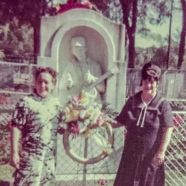
Image courtesy of Leola Crane Jones and the International Singing Brakeman’s Association Inc.
Share This
Print This
Email This
Sambo and Miss Harvey—My Neighborhood’s Gift
Within a span of three blocks in a hilly, tree-snarled neighborhood of old and middle-aged houses in Meridian, Mississippi, from the late 1950s to the early ‘70s, a sort of strange magic emerged from the lives of two artistic and rather eccentric individuals. Their creative energy would, in time, have a powerful reach. I had the privilege of seeing that magic take root and begin to alter other lives, for this was my place for growing up, and these were among my mentors.
One might say ours was the most ordinary of southern residential neighborhoods, but as I reflect now, a half-century later, Samuel Mockbee and Virginia Shine Harvey made it extraordinary. We didn’t realize it at the time, but Sambo, the lanky young man with artistic notions that couldn’t be contained, and Miss Harvey (she was married, but Miss had the right sound), a homegrown guitar teacher, would, respectively, influence the worlds of architecture and music.
These two offer notable illustrations of one truism conveyed by the Mississippi Arts and Entertainment Experience, a new state arts museum in Meridian (built downtown, a couple of miles from our old neighborhood): Great art and important art influences have a way of flowering in unlikely places.
It is the year 1968, I’m twelve years old and not at all concerned with what’s happening in the world, only with what’s happening in our little piece of Meridian . . . and Sambo, our neighborhood hero who is off at college, is home for a visit! And he’s just put the word out that all of us kids are invited over for a “very scary event.” If anyone else in the world had showed up in our neighborhood—the Beatles, a football star, the governor—we would not have been more excited. With intricate planning, Sambo proceeds to involve several of us in the scariest “manhunt” ever inside his creaky old two-story house; we have to search for a dead Confederate soldier, who turns out to be Sambo, dressed in full uniform and with sword, hiding in a coffin in the attic.
Later that same day, I carry my beginner-guitar around the corner to Miss Harvey’s chicken coop–turned–music studio in her backyard, anticipating playing songs like “House of the Rising Sun” for her by memory, with none of the boring drills or chord charts favored by other music teachers. I just want to learn to play and sing cool songs on my guitar, and Miss Harvey, like a nurturing hen in her henhouse, is ready to make sure that happens.
All the kids in our neighborhood worshipped Sambo, a mischievous and generous personality who relished creating all sorts of things. Just across from our house on 25th Avenue, he had turned his screened-in, slanting side porch into a full art studio, cluttered with half-finished paintings, pottery wheels, mannequins, and clay models. Sambo was everything we wanted to be—adventuresome, unconventional, funny, and slightly mysterious. Adults in the neighborhood (including my mother, a community college theater instructor) mostly tolerated his antics, but us kids were mesmerized.
Sambo’s house became a make-believe world rivaling any found in a Harry Potter novel. Along with his unusual art studio, he fashioned all sorts of games, competitions, magic shows, “secret rooms,” and “house tours,” the latter featuring moments that were among the scariest of our young lives. Sambo was a living, breathing showman who employed Hollywood-caliber special effects. He stoked our collective imagination.
At the time it seemed all just fun, but Sambo somehow was also testing his limits, preparing for bigger things. Little did we suspect that within a few short years Sambo would help revolutionize the old approaches of architecture, turning Auburn University’s School of Architecture into a mecca for using building design as a tool for social change, addressing rural poverty, and tackling other community needs. Well into his teaching career, he would note that as an architect he carried responsibility for “shaping the environment, of breaking up social complacency, and challenging the status quo.” Sambo told his students, “It’s got to be warm, dry and noble.”
- Sambo Mockbee and his walking stick
- Sambo Mockbee with Rural Studio students
- Sambo Mockbee
Three blocks away from Sambo’s house on our shady residential lane, a very different scene could be found at Miss Harvey’s modest home, which faced the busier Popular Springs Drive. There, this sweet soul of a musician, called Hortense by friends, held court almost every day and night in her crowded studio. Miss Harvey’s “open-invitation” rule made room for students and musicians of all levels of skill and sophistication. Her own musical DNA ran deep; she was first cousin to Jimmie Rodgers, the world-acclaimed “Father of Country Music” and a Meridian native. Miss Harvey, who would later become an important support figure for the Jimmie Rodgers Festival, wrote many songs under the pen name Virginia Shine—a fact unknown to me and to many other young people she taught.
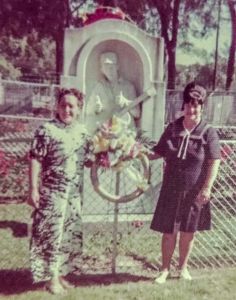
Miss Harvey (right) standing in front of a Jimmie Rodgers statue in Meridian’s Highland Park circa 1970 with Anita Rodgers Court, daughter of Jimmie Rodgers. Image courtesy of Leola Crane Jones and the International Singing Brakeman’s Association Inc.
Individuals who frequented her shack included local budding talents like Steve Forbert (whose 1979 hit Romeo’s Tune reached #11 on US Billboard Top 100) and musicians from around the state and beyond. While verification is elusive, one musician who is believed to have jammed in her modest studio was a young Elvis Presley, in town to perform in a talent show. Like Sambo, Miss Harvey was a magnet.
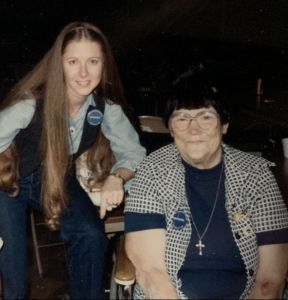
Miss Harvey (right) with Sheila Rippy, a staff member of the Jimmie Rogers Museum, 1984. Image courtesy of the Jimmie Rodgers Museum.
Sambo would look at me from a crack in his front door and in a booming voice say, “Dewey, are you too scared to enter the Temple of Doom, of which there may be no return?” And I would say, “No, I’m not scared.” Then the door would swing open and I would follow other kids into the darkened house.
Miss Harvey would ask me each week, “Honey, what do you want to play?” or “Play something for me,” as if I were some accomplished musician who had found my way to her studio. And as I played and sang (quite horribly), she would murmur “Oh, that’s good,” and “I like that.” I felt she really was interested in my own musical expressions.
Sambo’s and Miss Harvey’s engaging ways and their infectious love for their art forms would lead in different directions—Sambo to a radical use of architecture, Miss Harvey to a nurturing style of music instruction—but they both exuded exactly the same brand of creative magic. Without formal agenda, they fashioned a sort of petri-dish experience within three blocks. And as I reflect on those years, I wonder: Did this place, this safe cocoon of a southern neighborhood during this era, help create the bigger-than-one-life magic found in Sambo and Miss Harvey, or in the end did it really not matter where they were from?
I’ve come to believe that while many influences were at play, the setting was indeed essential. Our neighborhood actually did matter. This place helped nurture within Sambo’s and Miss Harvey’s artistic souls certain characteristics that later became more and more apparent.
First, Sambo and Miss Harvey would remain humble, eschewing more money and fame. Sambo’s life was symbolized by the porch—first his Meridian home’s dilapidated porch, where he was joined by neighborhood children; later, the porches at rural building sites, surrounded by students and architecture associates. Miss Harvey’s life was symbolized by her chicken coop–turned–music studio, where she charged $1.50 a lesson. Second, they practiced their art through others, operating more as teachers than solitary geniuses. They understood the power of passing on inspiration and ideas. Third, they used art for noble causes, especially those of delivering housing and a sense of dignity to the poor and helping others develop their own talents.
Finally, they often took something regarded as little or nothing and made it remarkable and lasting. Everything that happened at Sambo’s project sites in rural Alabama, and in Miss Harvey’s backyard studio in Meridian, helped create special out of the not-so-special. This echoes in Miss Harvey’s steady words of encouragement—“play something new,” “just play,”—and in Sambo’s relish for using mounds of discarded automobile tires to build handsome, durable structures. Sambo often was heard to say, “Take something ordinary and elevate it to something extraordinary.”
This all adds up to something, an enduring picture of what art and goodwill can do. That magic—living within a radical Sambo and a gentle Miss Harvey, nurtured for years just three blocks apart—became my neighborhood’s gift to the world.
*All images of Sambo Mockbee courtesy of Mockbee Family and Big Beard Films







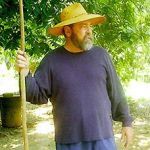
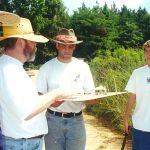
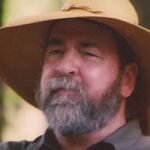
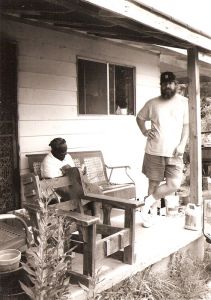
Gratitude and congratulations to Dewey Warner and South Writ Large on this splendid piece. I imagine that, though Sambo would still find a way to tease Dewey a little, both he and Miss Harvey would be moved and proud of him and for him.
Randy, thank you for your kind words. Your history with Sambo–as a Meridian kid and now with your program–is legendary. I salute your great writing work in New Orleans! Love to have a drink with you and Coleman next time I’m in the Big Easy. –Dewey
I would sit at Miss Harvey’s kitchen table and play for her and and listen to her stories about Jimmie Rodgers and her memories of sitting in his lap when she was a very small child. She made me feel special because she was so very special. I grew up on 24th avenue in that wonderful neighborhood.
Thanks for your note, Scott…yes, Miss Harvey was quite special, and our old neighborhood in Meridian was a special place…I wish a lot of kids could have had that place in their growing years…
Clay Barns and I went to her coup studio. It had egg crate walls.
You’re right, Shan–made for great acoustics!
You’re right, Shan, I remember…made for great acoustics!
“ Miss Harvey” was my maternal grandmother (I knew her as “Memaw”), and I was raised by her and my grandfather. I can attest to the fact that she was a wonderful lady. She loved everyone, and everyone loved her. She would have done anything that she could to help someone in need, and she had an incredible gift of making everyone feel comfortable and welcomed. I miss her tremendously. Thanks for such a fantastic article. It was very touching.
Thank you for your great note, Adrian…you were truly blessed to have had Miss Harvey as your Memaw…
What a beautiful, vivid article. I could see and feel the intellectual and moral effect these two people had on your life and only wish there were a Meridian everywhere for all kids. Thank you for taking the time to put this together, and the photos were essential, too. Dewey, I hope you know that you have successfully passed on the creative energy and love for life and humanity that your mentors gave you.